Hot Peppers For Health
Exploring the cultural history of peppers, their ancient wild progenitors, the many health benefits offered by hot peppers and pics/descriptions of four of our own homemade raw fermented hot sauces
Of the genus Capsicum (hot peppers) offer a long list of benefits to human health and have a rich cultural history. Long before they were known to Europeans (and by extension modern Canadians and Americans) they were known as "chīlli" (also spelled as "xilli" in some regions) to the Nahuatl speaking people of the Triple Alliance (aka "Aztec"). Chili peppers were known as "ich" to the Ch'olan-Tzeltalan speaking Mayan people, known as "Ucho" to the Quechua speaking indigenous peoples of South America (such as a Inca) and known as "kyynha" to the Tupi people of Brazil. Chili peppers have been used as a valuable medicine and food for countless generations by the Native American people of the south west, Central America and South America.
Ancient types of wild chili peppers still grow (without human help) in some places in North, Central and South America. We grow two wild varieties in our garden. Each offer their own unique flavor, cultural roots and characteristics.
Firstly, the Chiltepin pepper (Capsicum annuum var. glabriusculum). These peppers are the ancient wild ancestor that most modern pepper varieties can be traced back to (native to Mexico and Guatemala, now having been spread by birds and people, and becoming naturalized/self seeding from the canyons of the southern United States down to Peru).
I hope to extend that range quite a bit northward (we are growing 5th generation Chiltepin in our garden in Ontario now and they are actually becoming frost tolerant down to about minus 2C so far).
They are deceptively cute..
Some chiltepin peppers measure at over 100,000 scoville units (most ranging in heat from 50,000-100,000 on the heat scale).
For some perspective, that is 5-10 times hotter than a cayenne pepper (depending on the plant they come from and the climate/soil they are grown in, as peppers, --especially the wild chiltepin peppers-- vary in heat from plant to plant due to their vast genetic potential / diversity)
The second type of wild chili we grow in our garden is called the Aji Charapita pepper (Capsicum chinense). In a similar fashion to the Chiltepin, the Aji Charapita pepper looks more like a wild berry than a spicy chili. However, it is indeed the latter, and has a rich history and cultural significance in Peru.
The Aji Charapita has origins in the Amazon rainforest regions of Loreto and Ucayli.
Peru, along with Bolivia, are considered the “primary centers of diversity” for the Capsicum genus. Basically, Peru is thought to be the original birthplace of the chili pepper. Chili peppers have been documented to have been cultivated over 4,000 years ago in Peru.
Ají charapita is a found in large concentrations growing in the wild especially in the north of the Peruvian forest .
It’s cultivation originates from the cities of Iquitos and Pucallpa.
The plant grows preferably in areas with a hot climate, high humidity and soils with a high quantity of organic matter. You can sucessfully simulate its preferred growing conditions and grow these peppers outdoors (by growing in pots and in a garden microclimate in zone 5 and higher). In ideal conditions, it can reach a height of one meter and develop a rich foliage with oval shaped, light green leaves. Seeds are sown in winter, while the fruits are harvested in summer.
The plant begins to bear fruits after 60-120 days since the transplant and can continue to produce them for up to two months, depending on the area and climate. It is productive for six years, although the amount of fruits drops after year 4.
It has a fundamental role in Amazonian cooking, particularly in the province of Coronell Portillo, as it is the basic ingredient of many traditional dishes.
Considered an essential spice in countless Peruvian households, this pepper has been known to fetch high prices by weight. It has been rumored that chefs around the world have paid up to $25,000 for about 2 lbs. of dried aji charapitas. These claims are mostly hype though, as dried charapitas can now be bought online for about $15/oz or about $480 for 2 lbs. (at the time of writing this). That nevertheless, is still quite expensive indeed. The Aji Charapita comes in around 50,000 SHUs on the Scoville Scale. This is on par with the popular Cayenne pepper, but is well below the heat of a habanero. They are juicy and fruity, with very little bitterness. The seeds are tiny, so they don’t get in the way of the flavor or texture.
Progenitor species to our modern domesticated kitchen staples like the Chiltepin and Aji Charapita have a vast potential for genetic variation for breeding new varieties that have disease resistance and other favorable traits.
Though the fruit of Capsicum are used in some modern kitchens, the benefits are not fully accessed nor understood by many, leading to this amazing food and medicinal plant being widely dismissed and/or underutilized (when it is capable of adding much resilience, longevity and health to our lives.)
I have loved eating hot peppers ever since I was a child and that passion has only grown over the years. Earlier in life the my love affair with chilis was the result of a combination of my interest in Mexican, Thai, Korean and Creole cuisine with the fact that I was (and still am) biochemically addicted to spicy food. Though considering recent studies suggest that people who eat spicy food regularly live longer than people that do not (with those that regularly eat spicy food having a significantly reduced risk of dying from cardiovascular disease or cancer) that is an addiction I am happy that I invested myself in.
Recent studies closely looked at the health and dietary records of more than 570,000 individuals in the United States, Italy, China and Iran were used to compare the outcomes of those who consumed chili pepper to those who rarely or never ate chili pepper. Compared to individuals who rarely or never ate chili pepper, the analysis found that people who ate chili pepper had:
a 26% relative reduction in cardiovascular mortality;
a 23% relative reduction in cancer mortality; and
a 25% relative reduction in all-cause mortality.
That being said, many modern processed spicy foods that people eat do the opposite of nourish and heal and so in recent years I have sought to take my enjoyment of fiery foods and combine it with my knowledge of nutrition, herbalism and fermentation to optimize my homemade hot sauce recipes to be not only delicious condiments but also functional, medicinal superfoods. Store bought hot sauces often contain a long list of unpronounceable preservatives, lots of processed vinegar (which hides the flavor of the peppers) and their contents are cooked/chemically processed so that almost no nutrition is left in the end product.
Wild fermenting raw ingredients (to shift the PH into a range that can be preserved in the long term) and then making into a sauce offers the potential of not only preserving the nutrition of the ingredients used to make the sauce, but also increasing the bioavailability of those nutrients (through the metabolic activities of the lactic acid bacteria which help pre-digest the veggies, fruit and herbs) and adding a spectrum probiotic organisms (such as Lactobacillus plantarum, Lactobacillus brevis, Leuconostoc citreum, Lactococcus lactis, Weissella cibaria, Lactobacillus hilgardii and Enterococcus spp.).
That means that when you make raw fermented hot sauce you are not only getting access to the full nutrition of the peppers and other ingredients used to make the sauce, you are also replenishing and upgrading your microbiome (which serves to help you get more nutrition out of the other foods you eat via the action of the beneficial bacteria that set up shop in your gut when you eat wild fermented preserves, like raw fermented hot sauce).
Health Benefits of Hot Peppers
Chili peppers have amazingly high levels of vitamins and minerals. Just 100g provides (in % of recommended daily allowance):
240% of vitamin-C (Ascorbic acid)
39% of vitamin B-6 (Pyridoxine),
32% of vitamin A
13% of iron
14% of copper
Chilies also carry a good amount of other vitamins and minerals like vitamin k1, potassium, manganese, iron, and magnesium. Potassium is an important component of cell and body fluids that helps controlling heart rate and blood pressure.
Other Plant Compounds:
Chili peppers are a rich source of spicy-hot capsaicin.
They are also very high in antioxidant carotenoids, which are linked with numerous health benefits.
Here are the main bioactive plant compounds in chili peppers:
- Capsanthin: The main carotenoid in red chili peppers, responsible for their red color, and often accounting for up to 50% of the total carotenoid content. Its powerful antioxidant properties may act against cancer.
- Violaxanthin: The major carotenoid antioxidant in yellow chili peppers, accounting for 37-68% of the total carotenoid content.
- Lutein: Most abundant in green (immature) chili peppers, the levels of lutein decrease with maturation. Consumption of lutein has been linked with improved eye and brain health.
- Capsaicin: One of the most studied plant compounds in chili peppers. It is responsible for their pungent (hot) flavor and many of their health effects.
- Sinapic acid: An antioxidant, also known as sinapinic acid. It offers a variety of health benefits.
- Ferulic acid: Similarly to sinapic acid, ferulic acid is an antioxidant that helps protect against various chronic diseases.
The antioxidant content of mature (red) chili peppers is much higher than of immature (green) peppers. Scientific studies on experimental mammals suggest that capsaicin has anti-bacterial, anti-carcinogenic, analgesic and anti-diabetic properties. It also found to reduce LDL-cholesterol levels in obese persons.
It is fairly easy to grow hot peppers in pots in almost any climate. They will also thrive in ground in areas that offer from warm (18-26°C) to hot (26-40-s°C) summers. Plants can live for several years if they are brought inside and protected from frost over the winter.
Here is a list of some of the amazing health benefits of hot peppers:
1. Spicy Food Strengthens Connections Between Brain Cells:
Red peppers contain a compound known as apigenin, which has been shown to strengthen connections between brain cells. Other research has shown that apigenin, a flavonoid, may also be a a powerful agent in preserving key brain functions such as memory and learning. This, in turn, may provide protection against disorders such as Alzheimer’s Disease, Parkinson’s Disease, and some mental disorders such as schizophrenia.
2. Pain Relief:
Capsaicin, the main bioactive plant compound in chili peppers, has some unique properties.
Due to the powerful pain-relieving properties of the capsaicin from peppers, it can be applied to the skin to reduce the chemical P, the ingredient that carries pain messages to the brain.
Ultimately, the pain receptors exhaust themselves by depleting the body’s reserves. Once this happens, the capsaicin acts as a pain reliever.
It binds with pain receptors, which are nerve endings that sense pain. This induces a burning sensation, but does not actually cause any real burning injuries.
Even so, high consumption of chili peppers (or capsaicin) may damage the pain receptors over time, causing desensitization to the burning flavor of chili.
It also makes these pain receptors insensitive to other forms of pain, such as heartburn caused by acid reflux.
One study found that when red chili peppers (2.5 grams/day) were given to patients with heartburn (dyspepsia) it worsened pain at the beginning of the 5-week treatment, but improved it over time.
This is supported by another small study showing that 3 grams of chili each day for 6 weeks improved heartburn in patients with acid reflux.
The desensitization effect does not seem to be permanent, and one study found that it was reversed 1-3 days after capsaicin consumption stopped.
3. Weight Loss:
There is evidence that capsaicin, a plant compound in chili peppers, can promote weight loss by reducing appetite and increasing fat burning.
It does this through a process called diet-induced thermogenesis, which causes an increase in your metabolism.
In one study, people who ate a breakfast containing capsaicin and medium-chain triglyceride oil burned 51% more calories during that meal, compared to people who had neither for breakfast.
In fact, studies have shown that 10 grams of red chili pepper can significantly increase fat burning in both men and women.
Supporting this, other more recent studies have shown that capsaicin significantly increases fat burning.
Capsaicin may also reduce calorie intake. A study in 24 regular consumers of chili found that capsaicin before a meal led to reduced calorie intake.
Another study found a significant reduction in appetite and energy intake only in those who did not regularly consume chili.
4. Benefits the Digestive Tract:
This may sound counter-intuitive, but the capsaicin in peppers actually act as an anti-irritant. People with ulcers have been told for years to avoid hot spicy foods, but research has revealed that peppers are beneficial to ulcers.
For example, pepper powder provides trace amounts of anti-oxidants and other chemicals to aid digestive issues such as, healing an upset stomach, reducing intestinal gas, curing diarrhea and acting as a natural remedy for cramps.
It does this by reducing the acidity in the digestive tract that causes ulcers. It also helps produce saliva and stimulates gastric juices aiding digestion.
It also aids the circulatory system and prevents heart disease by lowering blood serum cholesterol and reduces lipid deposits, and therefore, reverses excessive blood clotting. It also dilates the blood vessels to aid in blood flow.
Additionally (and perhaps more importantly) Capsaicin prevents mitochondrial damage. Capsaicin is an active component of chili peppers that is extracted from capsicum plants. Recent studies have reported that Cap can ameliorate myocardial ischemia/reperfusion(I/R) injury. Mitochondria play an important role in pathways of apoptosis induced by myocardial I/R injury.
Since the capsaicin in pepper flesh has anti-oxidant and anti-inflammatory properties, it is being studied as a cancer-fighter. It reduces the growth of prostate cancer cells, while leaving normal cells unharmed.
Research also shows consumption of large quantities of peppers effective against breast, pancreatic and bladder cancers. (8 large habaneros per week)
7. Fights the Flu, Colds and Fungal Infections:
Hot peppers are chalked full of beta carotene and antioxidants that support your immune system and will aid in fighting off colds and the flu.
Research has found that nasal sprays containing capsaicin reduce congestion. Increased body temperature from the ingestion of hot peppers triggers the immune system into action in fighting the norovirus (cold), flu viruses.
Consumption of peppers fights against 16 fungal strains by reducing fungal pathogens.
With all that being said, moderation is always wise as one can take too much of a good thing. If you were to eat a couple fistfuls of ghost peppers in one sitting you would likely damage your stomach lining. Thus, combining hot peppers with Machoism is not only unattractive and obnoxious, it is also unwise from a health perspective.
Ok, now you know how amazing hot peppers are for your health, but how do you make nutrient dense medicinal hot sauces out of them? It is pretty simple really, it just takes tlc, patience and good quality ingredients. My method for wild fermenting our own garden peppers (and other ingredients that go into a sauce) are as follows.
If adding berries or other high sugar non pepper ingredients keep these to less then 1/10 the total volume of the fermented ingredients (this mitigates the chance of wild yeasts taking over the ferment, rather than the wild LAB you want to be working in there).
If fermenting whole peppers in a salt brine, use one tsp of sea salt dissolved into 250ml of water, make sure all ingredients are submerged in the brine (weigh them down somehow) and if sealing your fermenting vessel “burp” it at least once a day until the brine tastes how you want it (before blending to make the sauce). Add it to the fridge and enjoy within 6 months.
If making a fermented pepper mash (such as the Sizzlin’ Sriracha sauce described below) add one teaspoon of salt per 250 ml of pepper mash. Stir the mash daily to mitigate mold growth, taste each day after 5 days of active fermentation (discerned via CO-2 expulsion) until it tastes how you like it then either just put it in the fridge as is and enjoy within 6 months or puree with some honey for a more store bought sriracha vibe (while maintaining the nutritional/medicinal excellence of your homemade raw wild fermented version) and also enjoy within 6 months.
If you have read my previous blog posts, you may notice that many of the ingredients included in the recipes below were listed in my article about optimizing the innate immune system, and this was not by accident! :) I want my condiments to not only enhance the flavor of my food but also to nurture and heal my body, the recipes below are the result of combining seasonal garden abundances with the guiding thought of seeing food as medicine.
Now for the recipe ideas. The following are some sauces we like to make using our own homegrown seasonal abundances. Don’t feel tied to the exact ingredients, use what ever you seasonally have on hand from your garden (keeping the suggested guidelines above in mind) and have fun!
1.- Taste The Rainbow Berry Blast
With this raw fermented hot sauce I intended on doing what the skittles commercials have been advocating for years 😉
It included Beuna Mulata Peppers, Blueberries, wild Chiltepin Peppers, Orange Current Tomatoes, Cayenne peppers, black goji berries, elder berries, fresh blue berries, turmeric rhizome, Egyptian walking onion bulbs, sunshine and rainwater
2.- Chaga Infused Chipotle Sauce (made with dried smoked bhut jolokia, peruvian habeneros, wild chiltepin peppers, Datil peppers, black pepper corns, cumin seed, a bit of raw turmeric, ginger and a drizzle of honey dissolved into the chaga tea salt brine).

I added some active kimchi brine to get this one started. I blended this one up with some brine and about 1/4 the volume apple cider vinegar and turned out Phenomenal! packed full of anti-oxidant/beta glucan goodness!
3.- 𝗧𝗵𝗲 𝟳 𝗙𝗼𝗹𝗱 𝗙𝗹𝗮𝗺𝗲 𝗛𝗼𝘁 𝗦𝗮𝘂𝗰𝗲
Creating this sauce involved fermenting 7 immune system boosting herbs, spices and berries with 7 of my favorite heirloom pepper varieties.
The non pepper ingredients included (but were not limited to): Echinacea, Elderberry, Goji Berry, Peruvian Golden Berries (aka “Ground Cherries”), Ginger, Turmeric, Tulsi and Lemon Balm.
Pepper Varieties included (but were not limited to): Biquinho, Chiltepin, Jalapeno, Sugar Rush Peach, Peruvian White Habanero, Buena Mulata, Aji Charapita Peppers.
I fermented this mixture for a couple weeks then strained out the brine (for keeping separate in the fridge to be enjoyed as a potent apoptogenic, anti-viral and probiotic rich medicine). I love taking shot glasses full of the brine (which offers an explosion of floral and fruity flavors that yield to a deep glowing heat that lingers for 20 min or so).
After separating the delicious 7 flame brine I blended the solid fermented ingredients (with about one cup of brine and one cup of raw apple cider vinegar) to make a potent thick raw probiotic medicinal hot sauce.
The result was a very unique hot sauce with a color that reflects the high levels of curcuminoids, lutein and beta-carotene present in the sauce. When you eat a spoonful it starts with a bright, complex and deeply satisfying flavor. The first thing you taste is the fruity and smokey notes from the Biquinho, Aji Charapita and Chiltepin, then notes of cloves come along (from the Holy basil) and last but not least there are floral notes with a hint of vanilla (from the echinacea flowers and Peruvian white habeneros). The heat is present but not overwhelming, it lingers like the soft glow of the embers in a late night camp fire that fades gradually.
As this sauce contains a good amount of Tulsi aka "Holy Basil" (three different varieties in fact), Ginger and Turmeric it is a sauce rich Phenolic compounds such as (Rosmarinic, Gallic and Chlorogenic Acids), Triterpenoids (Ursolic Acid), Tetrahydrocurcumin, Gingerols, zingiberene, and zingerone, Volatile Oils (ß-Caryophyllene, Linalool, Ocimol, Eugenol) as well as Organic Acids (including Acetic, Gluconic and Succinic acids), Vitamins: A, B1, B2, B6, B12 and C... Minerals: (including but not limited to Potassium, Zinc, Calcium, Magnesium, Gluconate and acetate forms (Mn, Fe)) Amino acids such as Tryptophan and Enzymes such as Hydrolase, Lipase, Amylase And Much More!
These compounds (and many others) that are contained in this raw fermented hot sauce give it antimicrobial (including antibacterial, antiviral, antifungal, antiprotozoal, antimalarial, anthelmintic), anti-oxidant, anti-cataract, anti-inflammatory, radioprotective, hepato-protective, neuro-protective, cardio-protective, anti-carcinogenic, analgesic, immunomodulatory, memory enhancing, anti-ulcer, anti-arthritic, adaptogenic and anti-stress properties.
Thus, this sauce is not only a functional super food, but also a powerful medicine. Who says our condiments can't be both delicious, nutritious and medicinal!? ;)
4.- Sizzlin’ Sriracha
Sizzlin Sriracha includes a whole rainbow spectrum of our heirloom garden peppers (including Bhut Jolokia, Beuna Mulata, Biquinho, Aji Charapita, Cheyenne, Sugar Rush Peach and Chiltepin peppers).
Some of my hot sauce enthusiast friends keep telling me that there is a Sriracha shortage, I tell them not in our household! We have a Sriracha Abundance! 🙂 😉
Also, it is worth reiterating that unlike the store bought sriracha (which is really just a watered down, homogenized, Americanized version of sambal oelek) making your own raw fermented 'sriracha' sauce with heirloom peppers means that the high levels of vitamins (which are naturally present in the ripe peppers) and are left intact in the finished sauce via this method, it is also rich in probiotic organisms and the flavor is much more rich and nuanced.
For those of us that are growing our own heirloom crops, saving seed from the toughest plants year after year and creating recipes that preserve seasonal abundances... the word 'shortages' is not part of our vocabulary.
And now for a quote that is near and dear to my heart which speaks to the pertinence of the info shared above in the context of our current global situation:
“The problem with killing 99.9 percent of bacteria is that most of them protect us from the few that can make us sick.
Given the 'War on Bacteria' so culturally prominent in our time, the well-being of our microbial ecology requires regular replenishment and diversification now more than ever.
Wild foods, microbial cultures included, possess a great, unmediated life force, which can help us adapt to shifting conditions and lower our susceptibility to disease. These microorganisms are everywhere, and the techniques for fermenting with them are simple and flexible.
To ferment your own food is to lodge an eloquent protest--of the senses--against the homogenization of flavors and food experiences now rolling like a great, undifferentiated lawn across the globe. It Is also a declaration of independence from an economy that would much prefer we were all passive consumers of its commodities, rather than creators of unique products expressive of ourselves and the places where we live.
Resistance takes place on many planes. Occasionally it can be dramatic and public, but most of the decisions we are faced with are mundane and private. What to eat is a choice that we make several times a day, if we are lucky. The cumulative choices we make about food have profound implications. Food offers us many opportunities to resist the culture of mass marketing and commodification. Though consumer action can take many creative and powerful forms, we do not have to be reduced to the role of consumers selecting from seductive convenience items. We can merge appetite with activism and choose to involve ourselves in food as co-creators.”
― Sandor Ellix Katz
When you are making a raw fermented hot sauce you can separate the seeds from the ripe peppers and share them to create exponential regenerative and health increasing ripple effects in your local community. This is a concept I explored in two other blog posts (one focusing on Kale and the other on Elderberries.) The following set of pics shows how I save seed from our small wild chilies (while also saving the pepper pod for making sauce with). You can do this with any type of ripe heirloom pepper as well.




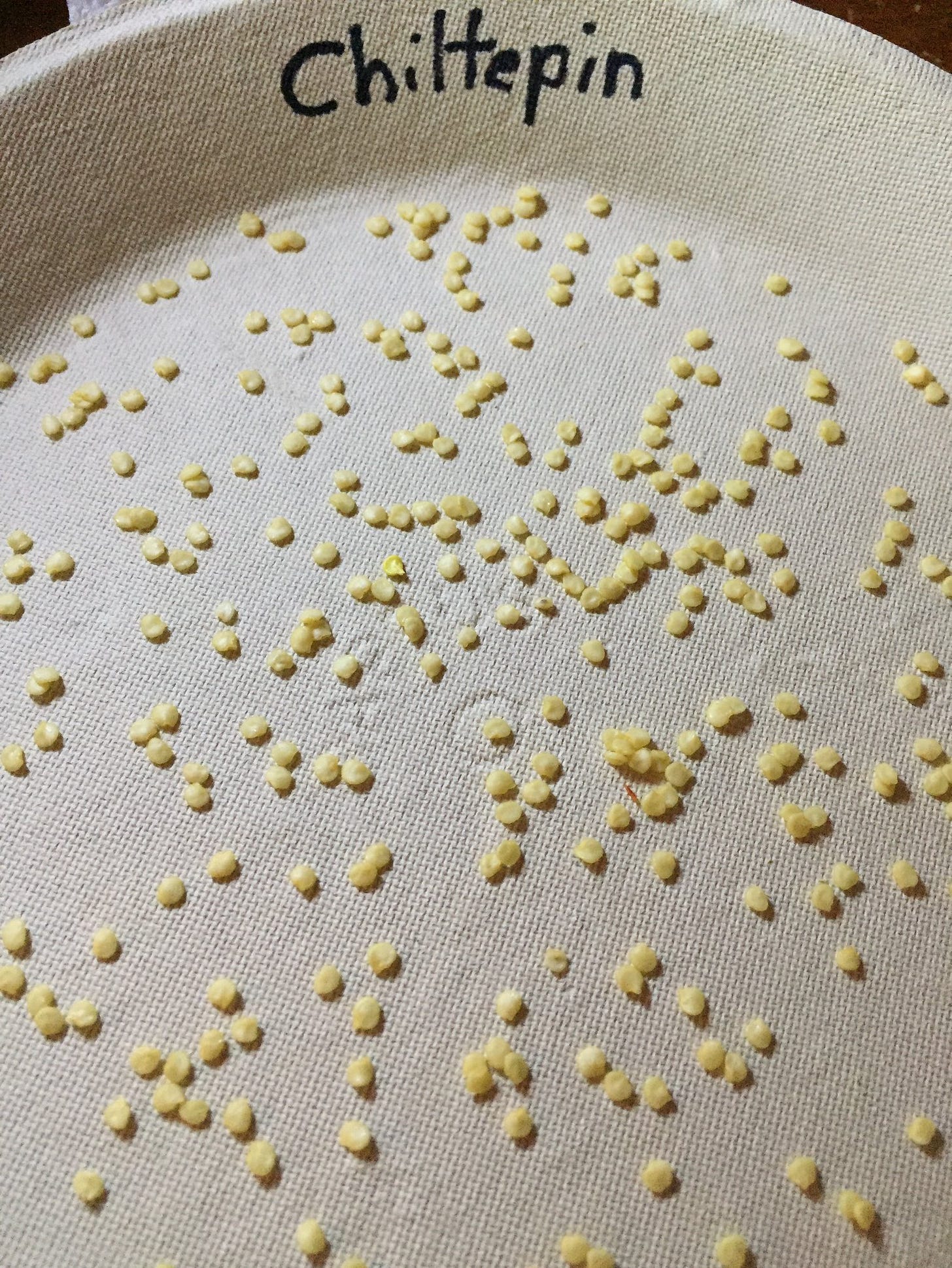
Step 7: Share your sauce(s) with friends, family and strangers and more importantly, share those seeds far and wide!! :)
Each of us can use the magic of lacto-fermentation to experiment and create preserves and condiments using the nutrient dense/medicinal crops which are abundant in our gardens (and sharing seeds at the same time) with amazing results. The sky is the limit! Dream big, don't be afraid to use unusual ingredients and get fermenting!
These challenging times we are living in are offering us an opportunity to see how decentralization, localization and food/health sovereignty are key pathways towards a resilient future. This is true both on the scale of individual households and communities.
While hot sauce shortages may just be a minor inconvenience for some (or totally not on other's radar at all) the increasing occurrences of shortages like this are really the 'canary' in the hyper-centralized, monoculture driven, synthetic fertilizer dependant 'coal mine' of a food system. It is a food system that is not only unreliable due to flimsy supply lines and being degenerative/extractive by nature (which will inevitably result in soil depletion/erosion and decreased yields year after year leading to total crop failures in the future) but there is also an increasing amount of evidence that it is a food system that is being intentionally destabilized by plutocrats and their puppets).
Thus, the imperative of growing your own heirloom crops, saving seed, and building soil becomes ever more clear. And just for the sake of argument lets say I am wrong about all the problems relating to the centralized agricultural and food system above, what is the worst that can happen if people chose to grow and preserve more of their own food, save heirloom seed and build soil? Increased locally defined culinary creativity and longevity perhaps? More people having access to tastier, more interesting food than one can get at the grocery store? Preserving heirloom varieties for future generations? You guessed it! All of the above! 🙂
It is my hope that you try making your own version of these sauces sauce at home, save seed from your homegrown peppers and then share those seeds. May this creative process and act of nurturing yourself and your community bring you increased longevity, joy, purpose, fulfillment and resilience.
(several sections of what was shared in the article above were excerpts from my upcoming book. If you enjoyed the content of this post and want to learn more about my book or pre-order a copy you can do so here )


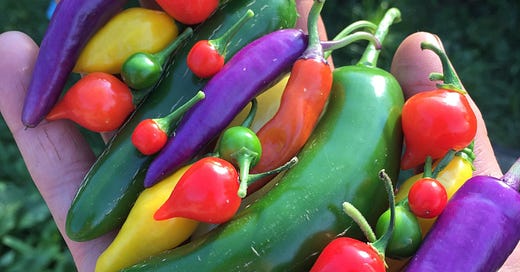




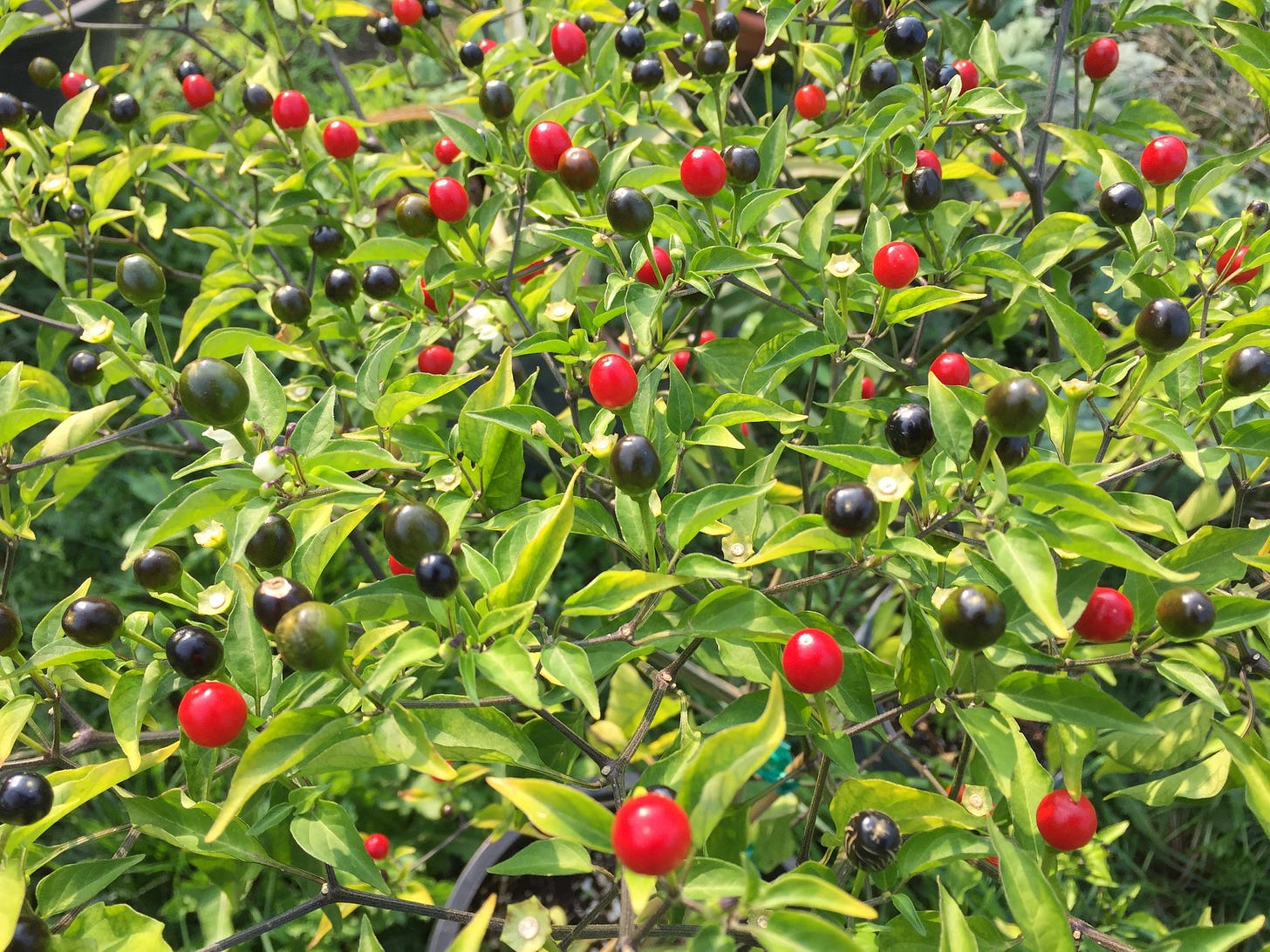


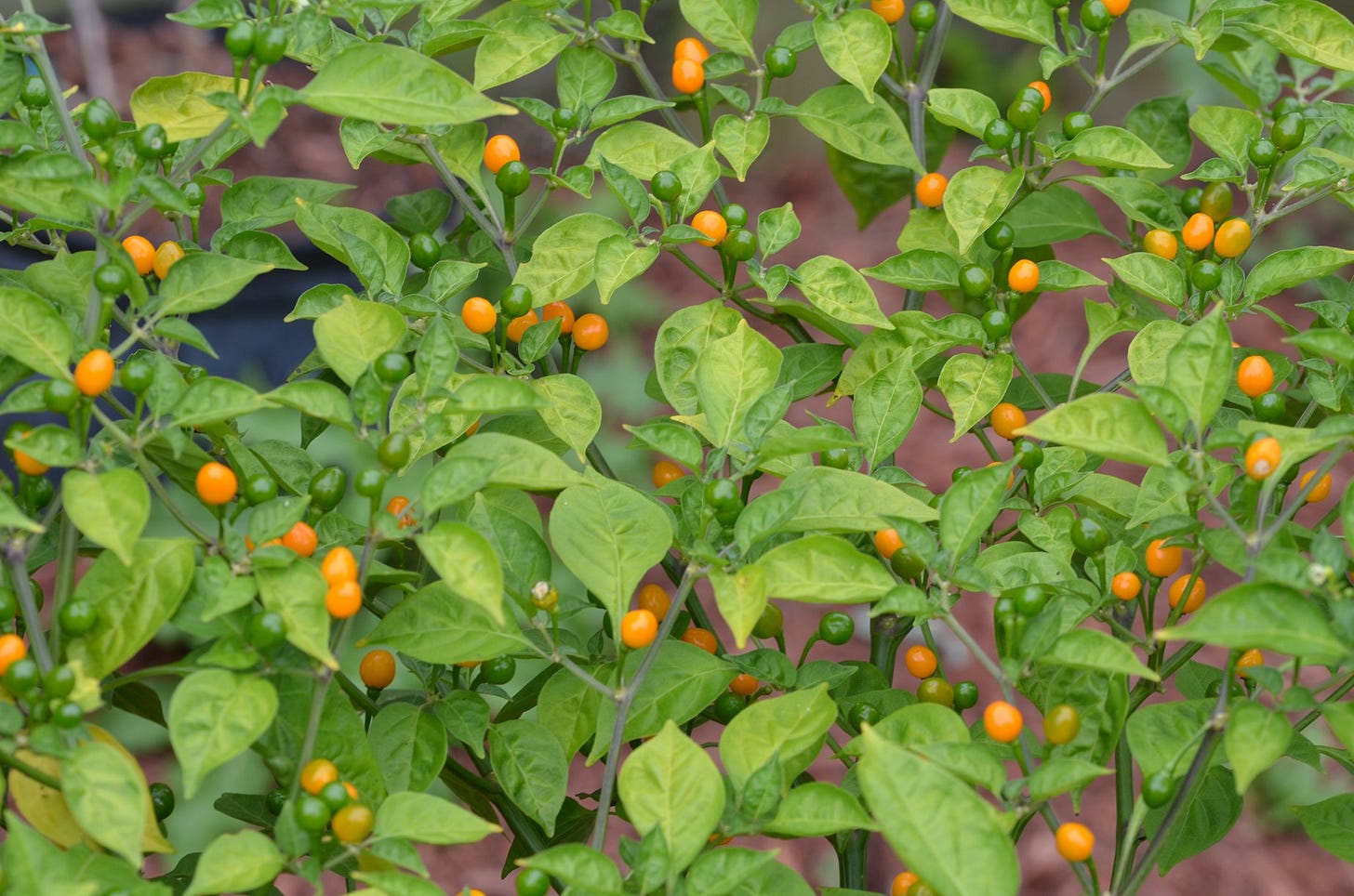


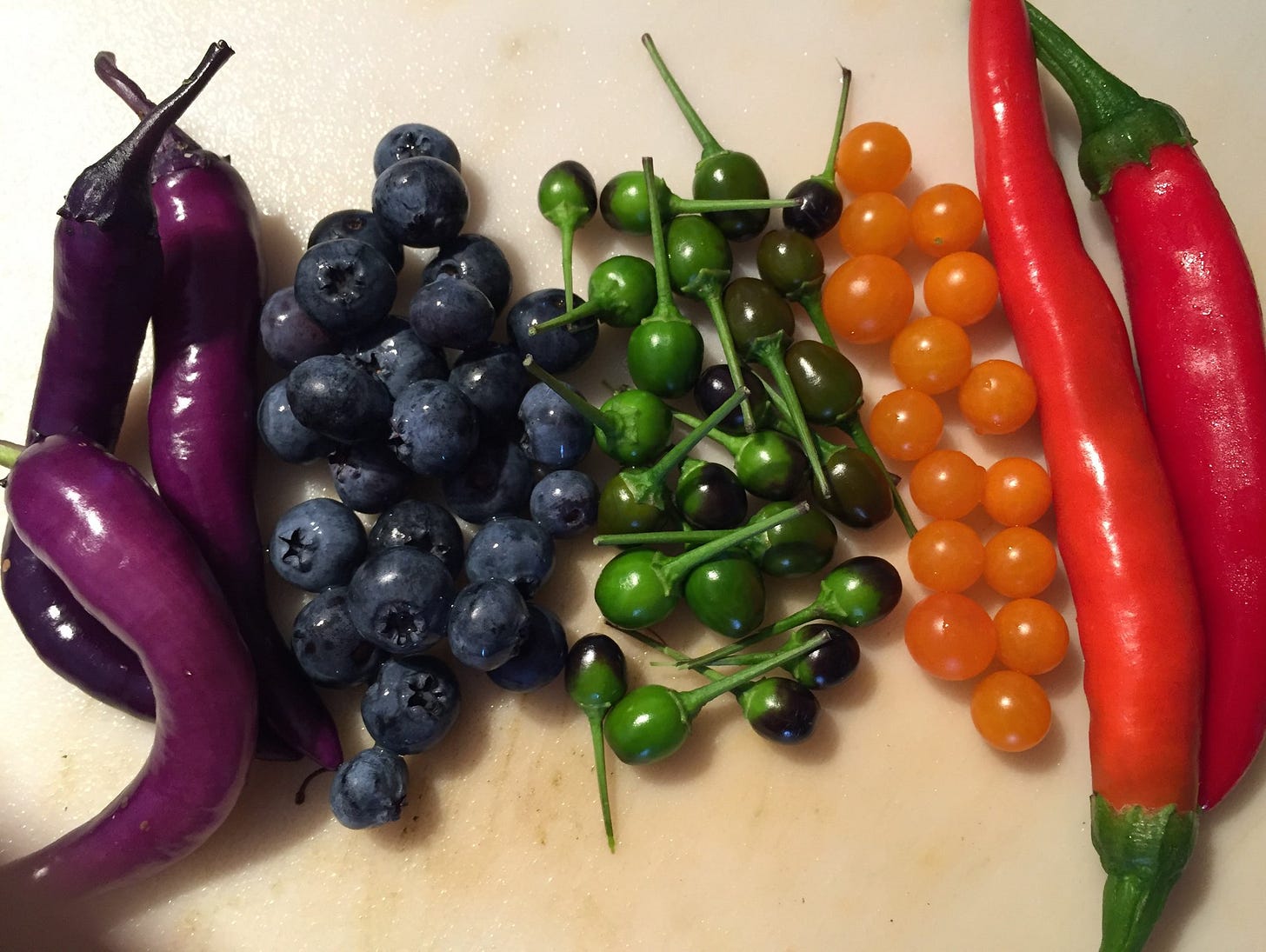




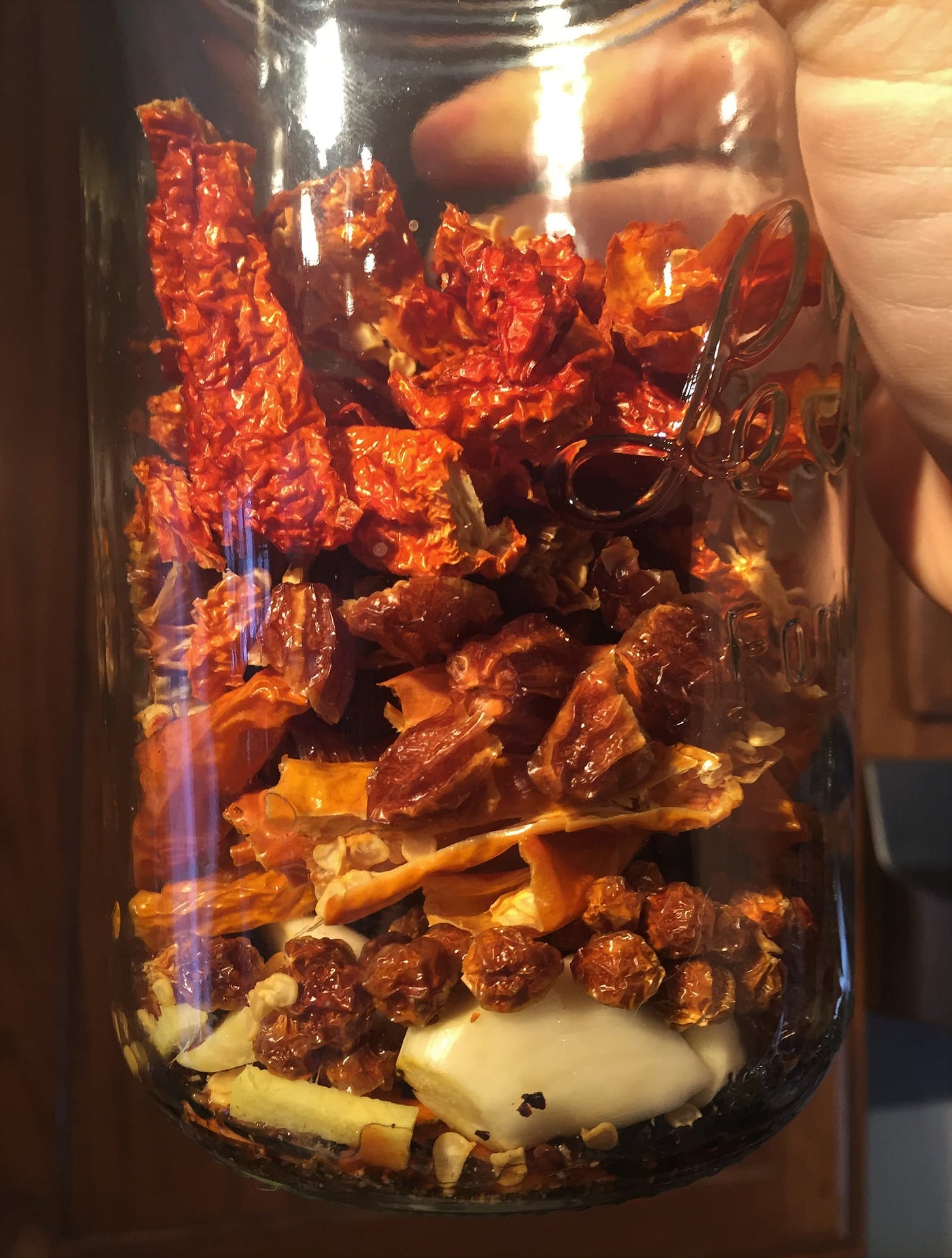





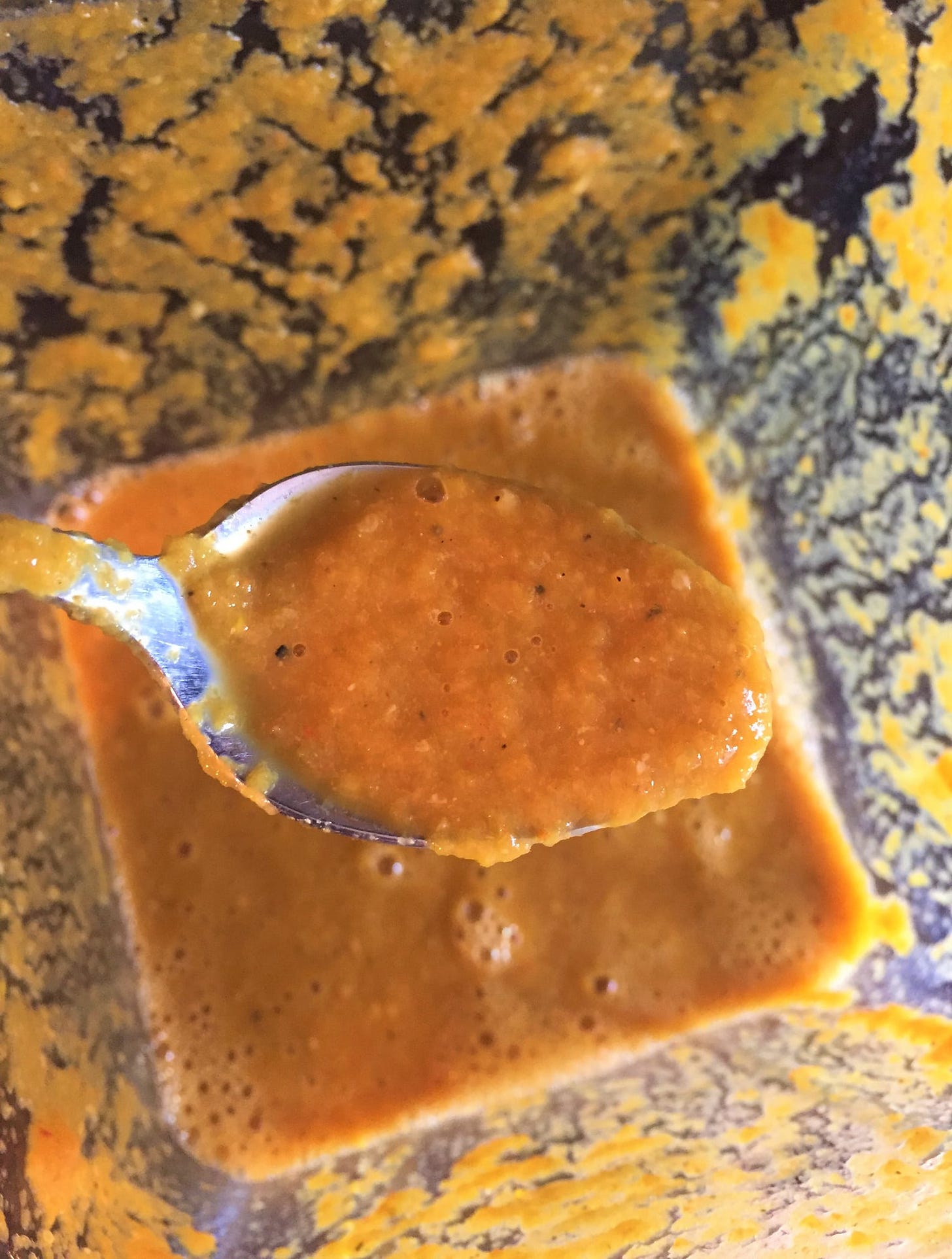
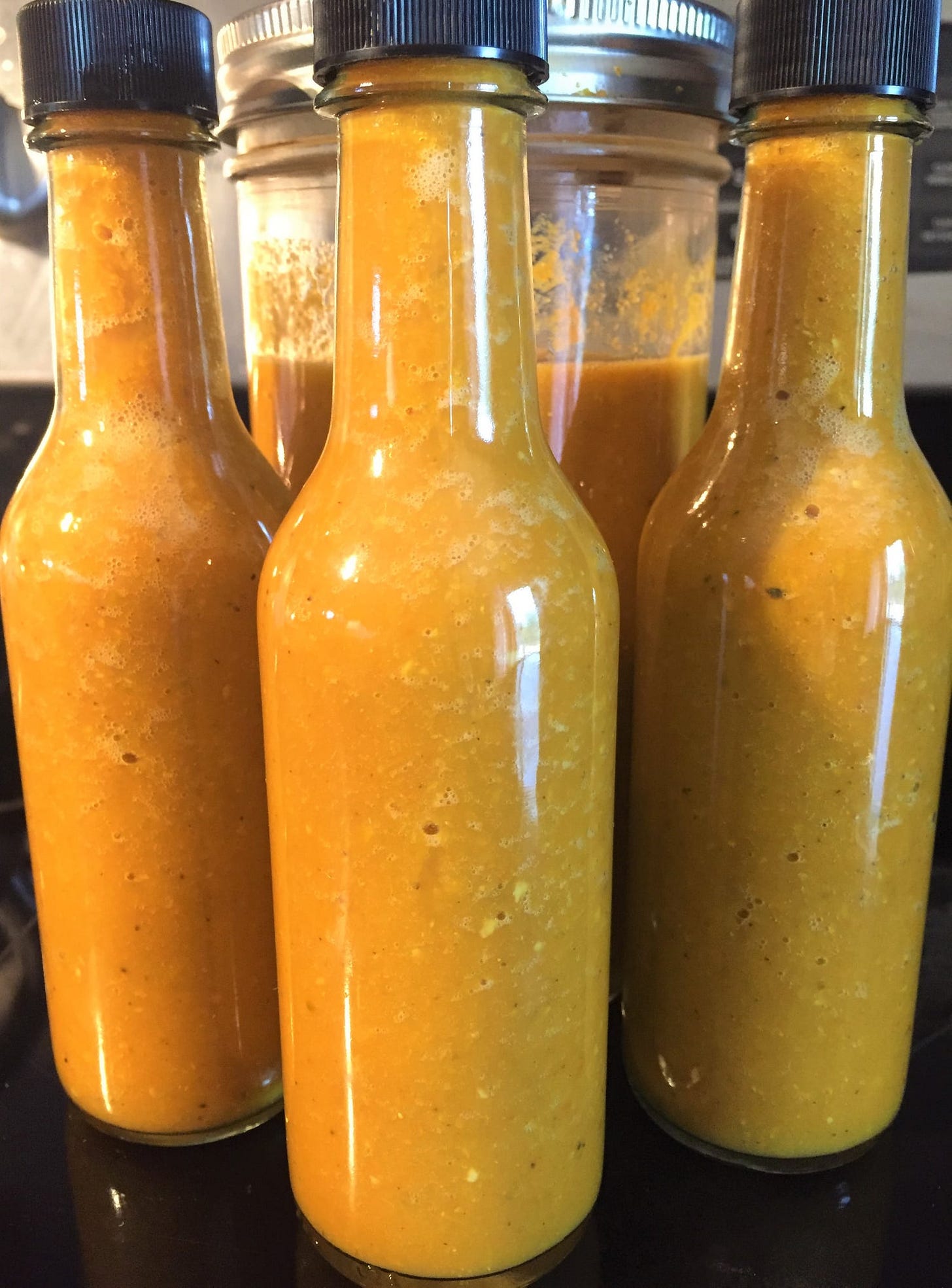



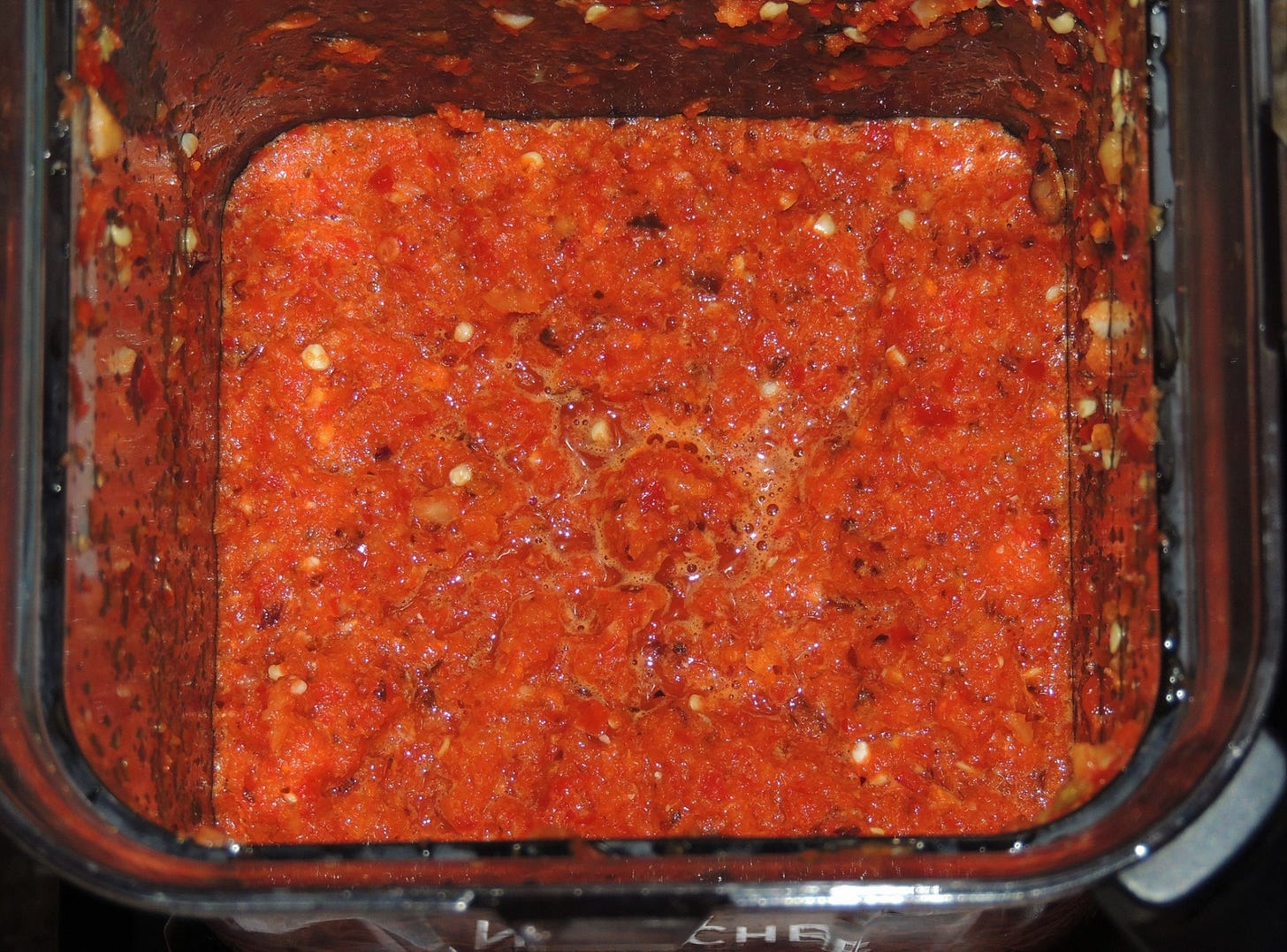
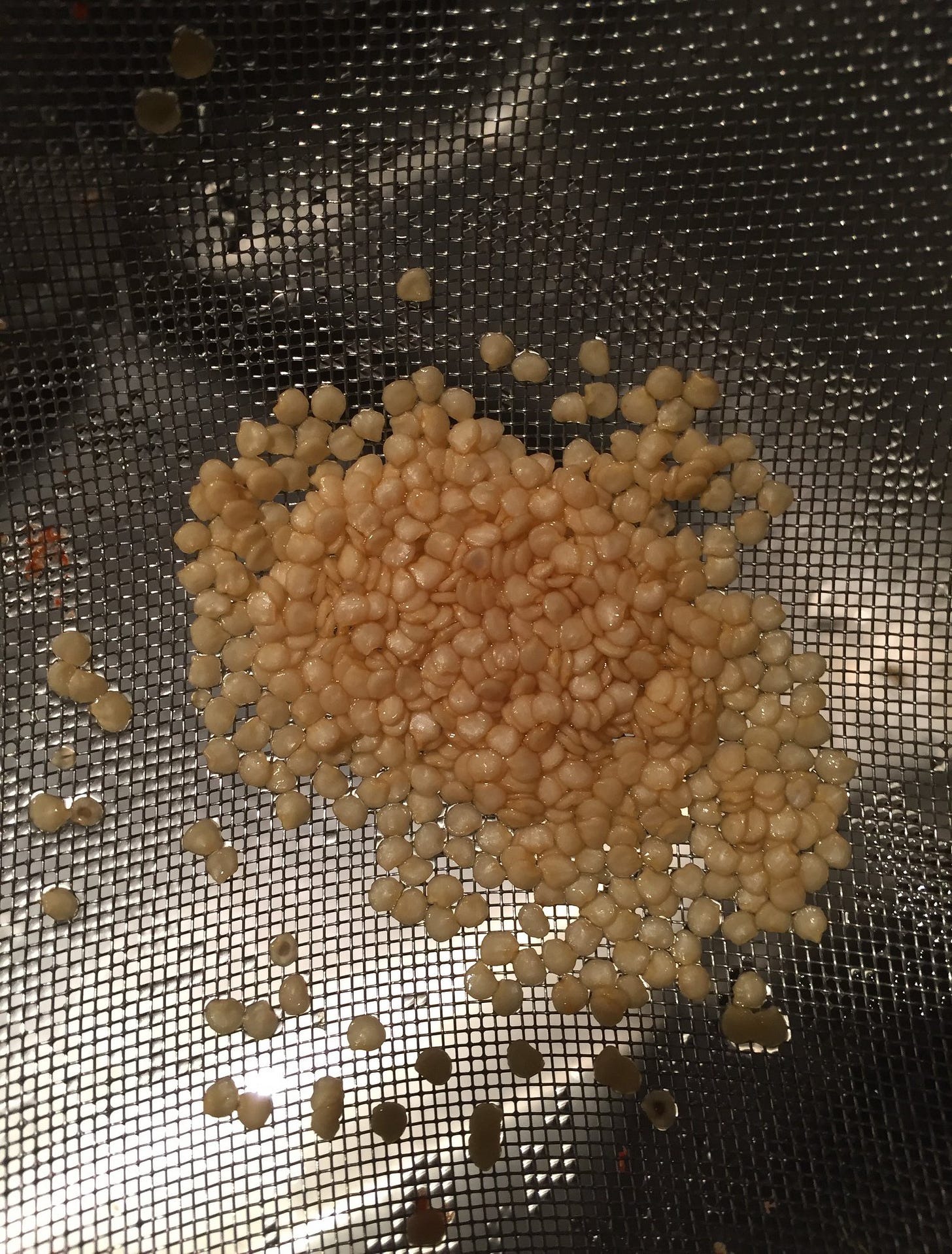
Thanks for all the effort you went through to write and share this seriously informative article! I know that i will be referring back to this over and over again. I also really appreciated the colorful accompanying pics. Guess i am going to have to eat more hot peppers.
GOOD!😊💥💖